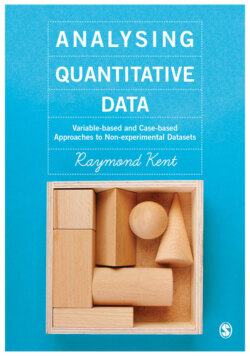Читать книгу Analysing Quantitative Data - Raymond A Kent - Страница 11
На сайте Литреса книга снята с продажи.
Introduction
ОглавлениеAll research involves analysing data at some point – but what do we mean by ‘data’? What kinds of data are there? How are they constructed? How are quantitative data structured? This chapter provides an overview of the nature and characteristics of data in general and shows how quantitative data in particular are constructed and structured.
The procedures used by researchers to structure and analyse a dataset are illustrated throughout this text with a study carried out by the Institute of Social Marketing at the University of Stirling, which studies the impact of alcohol marketing on the drinking behaviour of young people aged between 12 and 14. The findings are based on a survey that involves an interview-administered questionnaire measuring awareness and involvement with alcohol marketing and a self-completion questionnaire measuring alcohol drinking and associated behaviours. The homes of all second-year pupils attending schools in three local authority areas in the west of Scotland were contacted, generating a sample of 920 respondents (Gordon et al., 2010a).
The key research hypotheses are that the more aware of and involved in alcohol marketing that young people are, the more likely they are to have consumed alcohol, and the more likely they are to think that they will drink alcohol in the next year. To measure awareness, respondents are asked if they have seen any adverts for alcohol in any of 15 channels, for example television, cinema, newspapers, websites or sponsorships. Responses are recorded into ‘Yes’, ‘No’ and ‘Don’t know’. To measure involvement in alcohol marketing, pupils are asked whether they have, for example, received free samples of alcohol products, free gifts showing alcohol brand logos or promotional mail or email.
Drinking behaviour is measured in four main ways. Drinking status is assessed by asking whether pupils have ever had a proper alcoholic drink, not just a sip. Future drinking intention is assessed by asking about the likelihood that they would drink alcohol during the next year – ‘Definitely not’, ‘Probably not’, ‘Probably yes’ and ‘Definitely yes’. They are also given a ‘Not sure’ option. Initiation is measured by asking how old they were when they took their first drink, plus a measure of the number of alcoholic units last consumed. The study uses a range of control variables suggested in the literature, for example parental attitudes towards drinking and alcohol consumption, perceived parental drinking approval, sibling and peer drinking behaviour, liking of school and rating of school work. Demographic controls include gender, social grade (based on the occupation of the head of household), ethnicity and religion. The data from the alcohol marketing research are available online from the Sage website, https://study.sagepub.com/kent.
